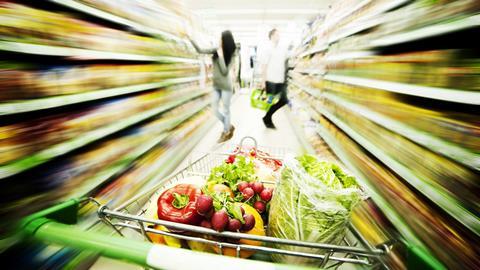Shoppers are buying fewer groceries as the cost-of-living crisis grows
Volume sales have fallen substantially at supermarkets as shoppers buy less food amid price inflation and pressure on their wallets.
NielsenIQ data shows a 4.7% increase in in tillroll sales in the four weeks to 8 October, but a decline in volume sales of 6%, compared to a 5.4% drop in September. That indicates that shoppers are spending more money for fewer goods.
Value sales of fresh produce fell 3.2% in the latest four weeks, while volume sales slumped by 8.3%, representing one of the weakest categories in the supermarket.
Coping strategies
According to data from NielsenIQ’s survey of shoppers in August, British shoppers are focusing on three main coping strategies to manage rising inflation. These include monitoring the cost of their overall shopping basket (26%), opting for private-label products (27%) and shopping more at the discounters (23%).
Asda was the fastest-growing of the top-three supermarkets over the 12 weeks to 8 October at 6.9%, followed by Sainsbury’s (+5.1%) and Tesco (+4.2%). Asda’s growth suggests that the retailer’s new strategies around range and price are already having an impact.
Mike Watkins, NielsenIQ’s UK head of retailer and business insight, said: “In recent weeks there has been a small shift away from fresh to frozen, slightly less spend on fruit and vegetables and fresh meat, fish and poultry and slightly more spend on impulse confectionery and soft drinks, with the latter helped by warm weather at the end of summer.
”The start of the 2022 FIFA Football World Cup should boost some categories, such as drinks and snacks, and there may be more meal occasions at home as friends and family get together to watch the sport at home. But as we edge closer to December the challenging external economic factors that impact household budgets such as concerns on mortgages and rising energy costs become greater.
“It’s still very uncertain how big the all-important Christmas weeks will be based on current trends and the added pressure on shoppers who may look to opt for cheaper alternatives. But what we do know is that shoppers will be monitoring their weekly grocery spend even more closely.”




